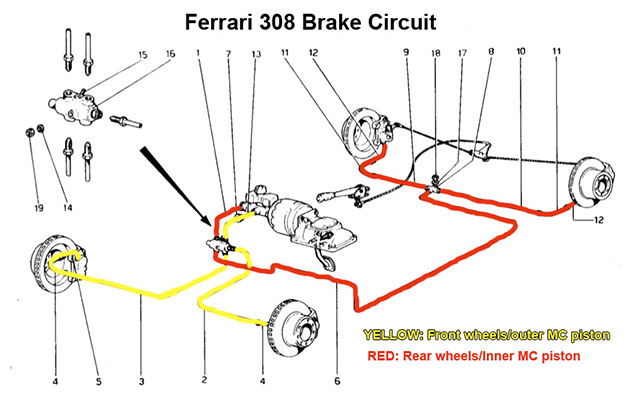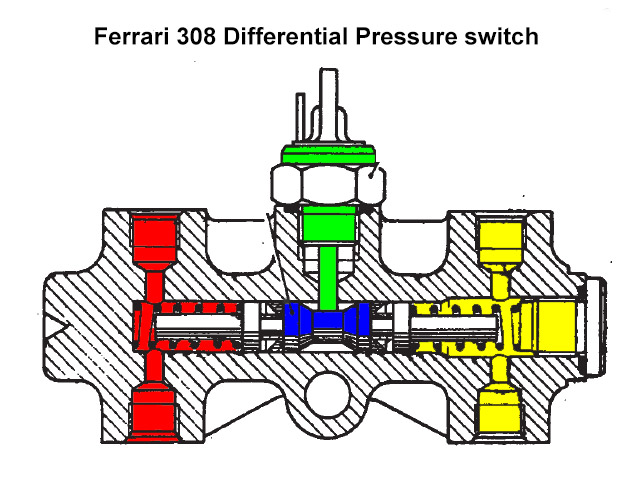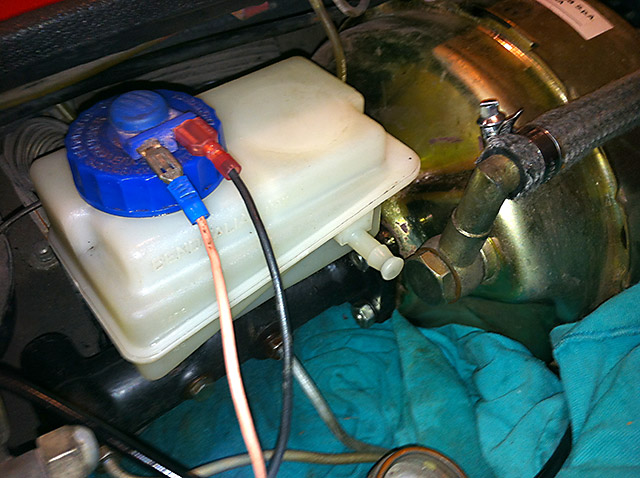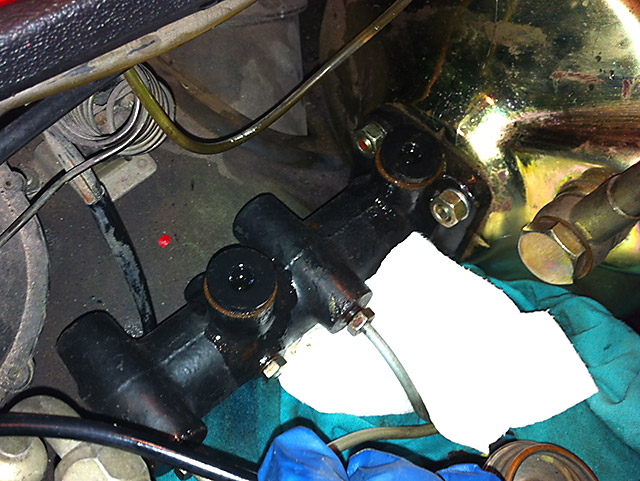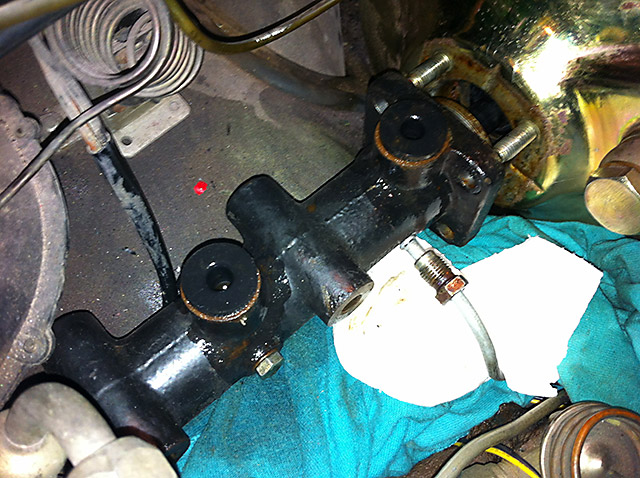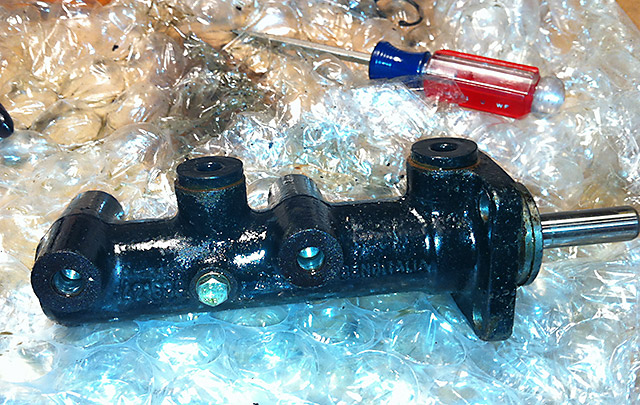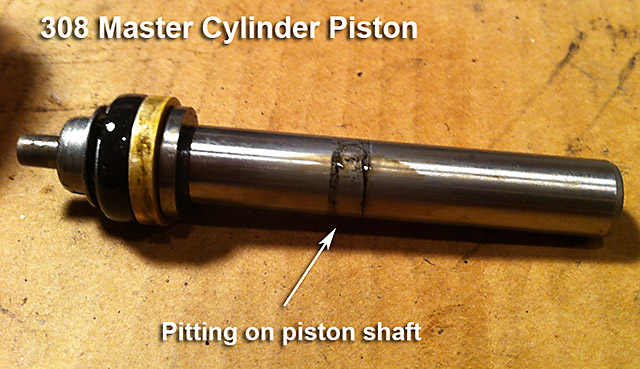
|
Replacing the 308 Brake Master Cylinder Birdman With any luck, you will never experience issues with your brakes. But these cars are getting old and so are the brakes. For me, I noticed that my brake master cylinder was leaking. Just a couple drops over the summer, but clearly the bore seal on my master cylinder needed replacing. Unfortunately, when I got it apart, I discovered terrible pitting on the plunger shaft, and realized that a new seal would not fix the problem. I needed a new master cylinder. (For purposes of this article to save typing I'm going to refer to the master cylinder as the MC). It's actually not that big a deal to replace the MC in a 308 but there are a few things you ought to know before you start. If you are not familiar with the inner workings of your basic dual circuit master cylinder, below is a diagram. I adapted this from one at Tegger.com, reversing it so it looks the way it looks when you are staring at it installed in a 308, with the pushrod from the brake booster coming from the right. There is a wonderfully complete write up of how a dual MC like this works here. Read it! In a 308, the innermost circuit (labeled the 1st circuit below) is attached to the rear brakes. The second circuit (outermost circuit) is attached to the front brakes. There are two separate circuits so that if you suffered from a ruptured brake line or failed caliper, one circuit might not work, but the other would. Both circuits are fed from a common reservoir of fluid (DOT 4 in a 308).
The brake lines come out of the MC and head down to a differential pressure switch. Many people mistakenly believe this contraption to be a brake bias valve. It is not. Here is a diagram of the 308 brake circuits.
The first circuit, in red, goes into the left side of the differential switch, then back out as a single line to the rear brakes. The second circuit, in yellow, goes into the right (and comes out two ports) and heads to the front brakes. To understand how it works, here is a cut-away view.
The rear brake circuit (in red) exerts pressure on a piston in the center (blue). The front brake circuit (in yellow) exerts pressure on the same piston in the opposite direction. As long as both circuits have the same pressure, the piston doesn't move. However, if there is a failure in one of the circuits, the other circuit would exert more pressure, and the piston would slide one way or the other, pushing up on the switch plunger (in green). This sets off a "brake failure" warning light on the dash. The good news is that this should tell you when you have a failure, and your brakes should still work somewhat. The bad news is that at this point, most of these differential pressure switches are internally seized up and don't work! So you can't trust them. If your brakes don't seem right, check them out, and don't trust this thing! So back to the master cylinder. When the 308 was made, Ferrari bought the master cylinder assembly from Benditalia (the Italian division of Bendix) complete with the brake booster attached. There is actually no Ferrari part number for the master cylinder itself, because it was never supposed to be sold separately from the brake booster. There is a good reason why. There is also a good reason why these days we have to deal with the two items independently--because the complete assemblies are no longer available, and brake boosters are expensive as hell. If you don't know what a brake booster is, or how it works: Read this. There is a critical relationship between the brake booster and the MC. When you take your foot off the brake, the brake booster retracts, taking with it the booster pushrod which pushes on the MC plunger. If the plunger cannot retract enough to come all the way out to rest, you may experience a condition where one or both of the fluid intake & return ports in the MC is not uncovered (look at the diagram above). If that happens, the fluid in the brakes cannot get back into the reservoir when you release the brake pedal. As the brakes get warm from driving, the fluid will expand. Without a place to go (the reservoir) it will start to push on the caliper pistons. Soon your brakes will be braking all by themselves and you will end up with a car that cannot move--even though you aren't touching the brake pedal. From the H9/H10 section of the 308 factory service manual: For a correct brake operation, it is necessary that the brake pedal performs a free travel of 8-10 mm before operating the master cylinder. For this purpose, the push rod inside the brake booster controlling the master cylinder is supplied by the manufacturer with adjusted clearance. This clearance must never be changed. It is therefore recommended not to disjoin the master cylinder from the brake booster. If necessary replace the complete unit. Ferrari never even wanted their own service department messing with the MC! At the Benditalia factory, when the MC was mated up to the brake booster, they adjusted a small nut at the end of the brake booster pushrod to adjust the length of the pushrod. See pic below:
The end of that nut goes into a hole in the MC punger and pushes on the piston. The first time I replaced my factory MC with an aftermarket one for the 308, I merely removed the old one, bolted in the new one, connected the brake lines, filled it with fluid, bled it, and went for a drive. Soon, I was cruising down the highway and I was losing power! I pushed in the clutch and blipped the engine--nope, that wasn't the problem. Yet the car was still losing speed rapidly! My brakes were binding all by themselves! It turned out that the replacement MC I bought had a slightly longer plunger than the original (only about 1mm longer!) By not reducing the length of the adjustable booster pushrod by the same amount, I had created a condition where the MC could not fully disengage as described above. I was really surprised that 1 mm made such a difference. As it turns out, you are much better off having a couple millimeters too much play than having 1 mm too little play. A little extra play just means your foot will go a bit further to the floor before the brakes kick in. But you can actually fine-tune that with the pedal linkage adjuster on the other side of the brake booster. A FEW HELPFUL HINTS FOR CHANGING THE MASTER CYLINDER 1. Beofre you start unbolting anything, remove as much brake fluid as you can from the reservoir with a turkey baster or something (and for crying out loud don't put that turkey baster back in the kitchen drawer!) Keep in mind that brake fluid is famously toxic to paint. Take precautions to keep it off the paint, and if you get any on the paint, wipe it off immediately, and rinse with water.
2. Put a big towel under the MC and remove the brake lines. Let all the brake fluid that is left drip onto the towel before you do anything else. 3. I could not get the MC out of the car without removing the reservoir because it blocks access to the rear nuts. Some people claim they can do it, so perhaps other models of the 308 are more accessible, but my early GTB--no way. To remove the reservoir, gently pry up on it. You have to be extremely careful to alternate prying on each end. It's just a press fit into the rubber grommet seals but there are barb fittings on the reservoir and it's made of fragile plastic. The reservoirs are rare as hen's teeth and more expensive than a replacement MC so be careful. Work gently and slowly. My Ferrari Mentor David Feinberg suggests a little heat, not too much, just a hair drier, to warm the MC will soften the rubber of the grommets and make it a little easier.
4. Once the reservoir pops off, the remaining brake fluid in there will spill. The towel can catch some of it. Then get your fingers over the holes on the bottom of the reservoir to keep the rest in, and get it the hell away from your car. Obviously, the fender of the car should be covered in towels for this operation. I like to have a big metal bowl waiting to drop the reservoir and MC in. Then you don't care about brake fluid trickling out of them. 5. Once the reservoir is gone, it's just (4) 13mm nuts that hold the MC to the brake booster. Once unbolted, you will have to gently wiggle it around the manuever it out around the AC lines. Be gentle with the pushrod from the brake booster which is in there.
6. Measure the distance from the bottom of the plunger indent to the face of the MC for both the old MC and the replacement. Adjust the brake booster pushrod accordingly. Remember having it be a little short is better than the alternative. There is no way to adjust it once the new MC has been put in except to take the whole damn thing apart again!
A FEW NOTES ON REBUILDING I have been unable to find a source of the seals to rebuild the MC. In theory, they ought to be standard sizes and the MC ought to be rebuildable at least by a reputable brake rebuilder. However, before you go and send it off to someone, you may want to have a look inside. The unit is not hard to take apart. Simply use a pair of snap ring pliers to remove the "inside" style snap ring circlip on the end, and then pull on the plunger. This disassembles the outer (second) circuit piston. Here is a picture that shows the parts (spring not shown, it's still inside the MC):
To remove the inner piston, there is a 10mm retaining bolt on the side of the master cylinder. This retains the inner piston assembly and simply removing it will allow the inner piston to come out. One word of caution however--use a socket extension or something to push down on the inner piston (against spring pressure) while removing the 10mm retaining nut, otherwise the piston will fly across the room! Before you decide to rebuild a master cylinder, you should inspect to see if it is a candidate. The surfaces inside the cylinder can generally be honed so if there is minor pitting/corrosion, this can be removed/resurfaced. But there is one trouble point on the master cylinder that can't be fixed:
As you can see, the piston shaft on my MC was badly pitted. This is why the thing was dripping in the first place. The pitting was caused by moisture around the seal when the car obviously sat for a long time. Over time, with driving, the pitting rubbing against the seal tore it up until it leaked. Replacing the seal would be pointless, it would be leaking again soon. Honing this wouldn't work because the damage is too deep. If you machined enough metal off to get rid of the pitting, you would need a tighter seal or it would leak. That alone is do-able, but keep in mind that this shaft also slides in and out of the vacuum seal of the brake booster, so that seal would have to be tighter too! Overall, it's probably better not to try to rebuild this unit. OBTAINING REPLACEMENT MASTER CYLINDERS As this is not exactly the most popular car in the world, there are precious few sources for replacement master cylinders. 1. eBay. You can find a used one on eBay. People are parting out wrecked cars all the time. But beware, you may end up with a MC in just as poor condition as the one you already have. Buying a used one is a crap shoot. Even under the best circumstances you will end up with a 25+ year old master cylinder! 2. AW Italian Autoparts. AW has a reasonably-priced MC for the 308 that fits fine and works great. It is not exactly the same shape as the original, but I seriously doubt anyone would notice, even at a concourse event. You do need to measure the plunger length and compare to the old MC you are removing and make an adjustment to your booster pushrod. (But you should do this with any MC replacement). The people at AW are super helpful. I have always dealt with David Lowenstein. 3. Ted Rutlands. Rutlands is now marketing a new production MC that they claim is made by Benditalia (original manufacturer) in the original style and dimensions, but they are definitely charging a premium for it. I have no experience with this MC but from the pictures it looks exactly like the original. I can't provide a link because at the time of this writing, his website is down, but he sells them on eBay. I hope of this helps for those of you contemplating solving 308 master cylinder issues! -Birdman My standard disclaimer: I am not a professional mechanic. I am a shadetree hacker at best. Take my advice at your own risk! Please, if you are not mechanically inclined, take your car to someone that knows what they are doing. Brakes are not to be trifled with! |

